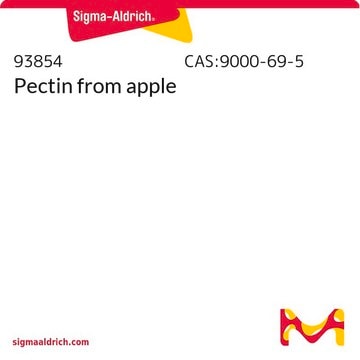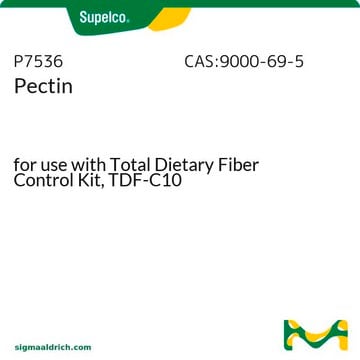P4300
Pectinase from Rhizopus sp.
suitable for plant cell culture, BioReagent, crude powder
Sinónimos:
Macerozyme R-10, Poly-(1,4-α-D-galacturonide) glycanohydrolase, Polygalacturonase
Iniciar sesiónpara Ver la Fijación de precios por contrato y de la organización
About This Item
Productos recomendados
Línea del producto
BioReagent
Formulario
crude powder
actividad específica
400-800 units/g solid
técnicas
cell culture | plant: suitable
temp. de almacenamiento
−20°C
¿Está buscando productos similares? Visita Guía de comparación de productos
Descripción general
Pectinase P4300 is a natural pectinase (polygalacturonase) derived from fungus Rhizops sp. that randomly hydrolyzes the (1→4)-α-D-galactosiduronic linkages in pectate and other galacturonans. This enzyme breaks down pectin found in the middle lamella of plant cell walls. Pectinase helps facilitate the maceration of plant materials and extraction processes. Pectinase P4300 is used in plant protoplast preparation to digest cell wall prior to organelle isolation.
Aplicación
Used in plant protoplast preparation to digest cell wall prior to organelle isolation.
Definición de unidad
One unit will liberate 1.0 μmole of galacturonic acid from polygalacturonic acid per min at pH 4.0 at 25 °C.
Palabra de señalización
Danger
Frases de peligro
Consejos de prudencia
Clasificaciones de peligro
Resp. Sens. 1
Código de clase de almacenamiento
11 - Combustible Solids
Clase de riesgo para el agua (WGK)
WGK 3
Punto de inflamabilidad (°F)
Not applicable
Punto de inflamabilidad (°C)
Not applicable
Equipo de protección personal
Eyeshields, Gloves, type N95 (US)
Elija entre una de las versiones más recientes:
¿Ya tiene este producto?
Encuentre la documentación para los productos que ha comprado recientemente en la Biblioteca de documentos.
Jeffrey A Mertens et al.
Fungal genetics and biology : FG & B, 45(12), 1616-1624 (2008-10-22)
A search of the recently sequenced Rhizopus oryzae strain 99-880 genome database uncovered 18 putative polygalacturonase genes with two genes being identical and only one with similarity to a previously reported R. oryzae polygalacturonase gene. The 17 different genes share
K Saito et al.
Journal of industrial microbiology & biotechnology, 30(7), 440-444 (2003-07-05)
Rhizopus oryzae strain NBRC 4707 produced lactic acid and ethanol more efficiently than strain NRRL 395 in potato pulp, an agricultural by-product of the starch industry. The two strains developed comparable activities of xylanase, cellulase, alpha-amylase, and glucoamylase, while the
Shigenobu Yoshida et al.
Mycological research, 108(Pt 12), 1407-1414 (2005-03-11)
The polygalacturonase (PG)-encoding gene (rpg1) of Rhizopus oryzae, the causal pathogen of rhizopus rot of mulberry, was cloned and sequenced. PGs were partially purified from incubation mixture of 2% pectin medium and their N-terminal amino acid sequences were determined by
Katsuichi Saito et al.
Microbiological research, 159(1), 83-86 (2004-05-27)
The pectinolytic enzyme from the solid-state culture of Rhizopus oryzae NBRC 4707 was purified to homogeneity by column chromatography on CM-Toyopearl 650 M and hydroxylapatite. The molecular weight of the enzyme was estimated by SDS-polyacrylamide gel electrophoresis to be 31,000
Peerapat Roongsattham et al.
BMC plant biology, 12, 150-150 (2012-08-28)
Cell separation that occurs during fleshy fruit abscission and dry fruit dehiscence facilitates seed dispersal, the final stage of plant reproductive development. While our understanding of the evolutionary context of cell separation is limited mainly to the eudicot model systems
Nuestro equipo de científicos tiene experiencia en todas las áreas de investigación: Ciencias de la vida, Ciencia de los materiales, Síntesis química, Cromatografía, Analítica y muchas otras.
Póngase en contacto con el Servicio técnico







